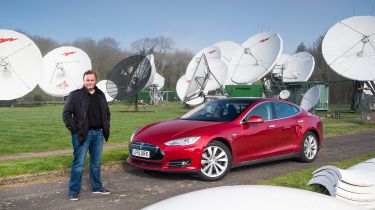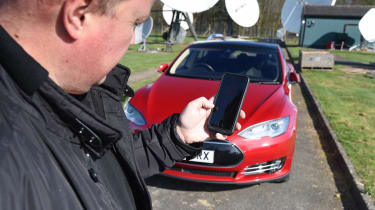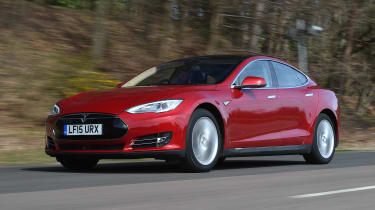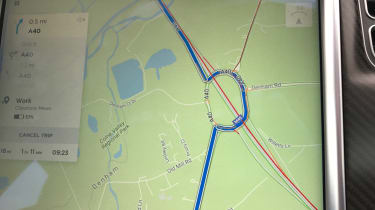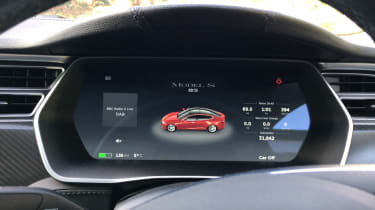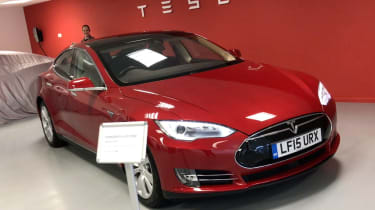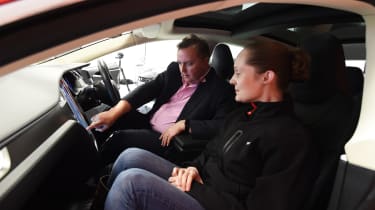Tesla Model S CPO used long-term test review
Final report: our last run of the tech-packed, space-age Tesla Model S

No wonder every other car maker is looking hard at what Tesla is doing. To rival premium manufacturers in such a short time is no mean feat. Time with the Model S has proved it’s a great car that’s easy to live with and viable to own. I’d buy one at the drop of a hat.
Mileage: 32,300
There’s something almost other-worldly about owning a Tesla. You get looked at – a lot. People know you’re driving something different. And it’s a real topic of conversation: “Oh, you’re running a Tesla – tell me more about it.” There’s a need-to-know among other car makers, too.
Perhaps the most unusual part of Tesla ownership is the over-the-air updates – which is why I took my car to mysterious Chalfont Grove, home of the Services Sound and Vision Corporation, which broadcasts to our forces around the world. The array of satellite dishes can be seen from space, so it seemed an apt place to take the Tesla for its final photoshoot.
My Tesla arrived six weeks ago (trust me, this is the longest Tesla has let anyone in the media borrow a car), as a used model with a difference. When it was first delivered it was nicely specced, but those cleverly distributed software updates have endowed it with Autopilot self-driving capability it didn’t have when it was new.
Other upgrades brought plenty of extra features, and I enjoyed three updates in my six weeks, including one on the final day, which updated the mapping and voice control functionality. But mostly, our time with the Tesla was to test how easy it was to live with this high-performance electric saloon day in, day out.
Used - available now

2016 Tesla
Model S
69,380 milesAutomaticElectric
Cash £26,087
2016 Tesla
Model S
78,000 milesAutomaticElectric
Cash £18,999
2019 Tesla
Model S
32,883 milesAutomaticElectric
Cash £31,400
2019 Tesla
Model S
62,950 milesAutomaticElectric
Cash £24,495Let’s start with the charging and ‘range anxiety’. The range of 244 miles meant I often didn’t need to charge the car for days – it’s all about planning usage. My 44-mile round trip to work allowed the best part of a week without plugging in, and if needed, there are Tesla Destination Chargers at car parks, hotels, etc.
My last weekend with the Tesla involved a trip to Liverpool, including an overnight stay at the Park Royal Hotel in Warrington with its Tesla Superchargers, which give an 80 per cent charge in half an hour. A stop at Keele services for another charge on the way home was the only other boost I needed. And it’s free energy – my car still gets complimentary top-ups courtesy of Tesla, while a charge at home costs little.
What about other aspects? It’s spacious – the rear bench and flat floor was a boon for my three children – build quality is good, and the powerful stereo delivers superb sound. Even though our 85 model has been superseded by performance versions, I never tired of the Model S’s incredible acceleration. The car’s maximum power is delivered instantly by the electric motor; the Tesla romps down the road.
Gripes were few; my wife and kids complained about road noise in the back, the dog wasn’t happy in the boot due to the slope of the rear screen, and I could’ve done with more lidded storage (newer models have a handy centre console).
So could I live with a Tesla? That’s a definite yes. Would I live with a Tesla? Another yes. They hold their value well. My car originally cost £70,000, and at two-years old will go on sale for £56,500. If I had the cash, I’d be sorely tempted.
Tesla Model S CPO used long-term test: third report
Our Tesla Model S used long-termer gets its first software update under our ownership
Nearly two thousand miles into Tesla ownership and the new car (well used in this case) excitement has yet to wear off. I’m also beginning to understand why Tesla topped last year’s Driver Power satisfaction survey.
Sure, there are minor frustrations that come to light when you’re living with a car day-in day-out. But in Tesla’s case it tends to listen to owners and, where possible, react with a software update.
Nothing can be done about certain things, though. Much as I love the spacious feeling of the ‘yacht floor’ between the front seats, some closed storage would be useful. Other owners obviously agree, which is why new Teslas come with a more traditional centre storage area. My car only has a glove box and two cup holders hidden beneath armrests. I’d love to lift the armrests up to reveal some added storage, too, but there’s obviously some electrical gubbins under there.
As there is, no doubt, a reason for there not to be any door bins. It’d better be a good one, because I could really do with somewhere to put regularly-used things like sunglasses.
There’s not much Tesla can do about those minor gripes, but making the clock more visible on the giant touchscreen would be good, as would some usability and information tweaks to the infotainment system – showing some data about the radio station you’re listening to, for example.
The navigation also makes some strange suggestions, too, like taking the long way around the tricky Denham roundabout just off the M40 when there’s a much more obvious (and clear) shorter route! To be fair, the navigation is powered by Google and it’s normally spot-on. I also experienced a touch of Artificial Intelligence the other morning when I got in the car, hadn’t touched the navigation and it assumed I was heading to work and not only told me of delays on my route, but suggested another. Really clever, but a little spooky!
Nav and infotainment fixes are entirely within Tesla’s gift and, who knows, maybe the rumoured upcoming software update will do that.
As it did to enable owners to unlock the charging port with the key – otherwise it means digging through the on-screen menus. Actually, I’m at a loss to understand why the charging port is locked anyway – it’s just a small flap by the rear lights that’s held shut by a magnet. But why does it have to be locked? Again, I’m sure there’s a reason – there usually is with Tesla.
That’s about the closest I can get to moaning about this car. It’s proving to be very easy to live with on a daily basis and when doing family duties.
The Fowler five love the space on offer inside – the flat rear bench and flat floor is a real boon in the back, reducing the amount of arguing.
Meanwhile the big boot at the back is so useful I tend to forget about the smaller boot at the front which, provides even more space for bags. And toddlers!
Colleague John McIlroy’s son Henry played ‘hunt the engine’ in the front boot. Hopefully Dad explained about the electric motors on the rear wheels.
One other thing I’m learning about is EV etiquette – the art of not blocking charging points if charging isn’t really needed. Running an EV is all about planning and knowing what journeys are coming up, thus avoiding the dash to plug in at every opportunity.
With a range of 220 miles on a full charge, that will last plenty of time in my Tesla – just about a full week of 44-mile round-trip commutes. So although the ‘full-fat’ Tesla Superchargers and ‘lite’ Destination Chargers are in useful places, careful use of home charging is all I’ve really needed.
Non-EVs parking in plug-in spaces is a continual frustration for EV owners, though – especially if you need a charge to be able to get home. But at one Tesla Destination Charger in a west London car park I spotted a sign that said the car park operators would move a non-EV parked in an EV space if that space was needed. A nice touch – it would’ve been interesting to see how they did that and a useful lesson learned by a selfish parker!
Tesla Model S CPO used long-term test: second report
Our Tesla Model S used long-termer gets its first software update under our ownership
How exciting! It’s rare that we get to experience something genuinely new and different these days, but that’s exactly what happened with our Tesla. Getting into the car one afternoon, the big screen flashed up with a message we hadn’t seen before: Software Update.
Other than telling me that the update would be done at 00:55 in the morning and that I could postpone it if I needed to (handy, as the system also warned me that the update would take one hour and 40 minutes and that the car couldn’t be used during that time), I had no clue what the update would include.
Previous updates had bestowed new powers on our used Tesla Model S since it first left the showroom – it didn’t have Autopilot and other driver assistance features when new; they came about courtesy of similar updates.
So it was with a new level of excitement the next morning when I approached the car and the door handles moved outwards to greet us – nothing unusual in that.
Getting into the car, the screen flashed up a new message where it usually shows my calendar appointments: “Update Succeeded - What’s new in this update?
“This release contains minor improvements and bug fixes.”
I can’t deny there was a slight sense of disappointment that my first ever vehicular software update didn’t produce something noticeable, but that was soon overcome when I realised just how ground-breaking this moment was for me. A free, over-the-air software update in my car. It’s something we’ve become accustomed to on our mobile phones, but not – yet – on our cars.
It’s been something I’ve been regaling friends with stories of and I’ve already had two of them seriously start to consider buying a used Tesla now knowing these software updates bring them up to a standard that’s not far off new.
Living with a Tesla is also something I’m being asked lots about by rival car makers. They’re all keeping a watchful eye on what Tesla is doing, many in advance of their own electric car launch. So they’re fascinated to know what it’s like from an owner’s point of view.
So far, this owner is thrilled to bits. This software update might not have made any noticeable difference, but it’s such a cool thing to have happened. And it’s another reason why the rest of the car world is going to be playing catch up with Tesla for quite a while yet.
Tesla Model S CPO used long-term test: first report
We add a used Tesla Model S to our fleet to see what it's actually like to live with a Tesla every day
There’s a lot to get your head around when you’re a Tesla owner, not least the groundbreaking array of technology fitted to every car.
But if, like us, you take delivery of a Certified Pre-Owned Tesla, there’s something else that’s a bit unusual for used car buyers: our near two-year old Model S is better today than when it first left the showroom.
When the first owners took delivery, their rear-wheel drive 85kWh car was at the cutting edge of tech. As well as traffic-aware cruise control and forward collision warning, it had auto high-beam and a smart reversing camera.
However six months later, an over-the-air software update added Tesla’s now-famous Autopilot system, which will not only keep a measured distance from the car in front, but also keep you safely in lane when it’s engaged – with you in control at all times, obviously. The system will also change lanes for you if it’s safe to do so – just operate the indicator and the car’s cameras and radar will decide when it’s safe to move, then do it for you.
A few months after that, the car was upgraded again to be able to park itself in perpendicular parking bays, while Summon was also added. This lets you move the car out of a tight parking space via Tesla’s smartphone app without even being in it! I’m looking forward to that one.
The updates go some way to explaining why Tesla residuals are so strong – our two-year old car cost £59,800 with 31,000 miles on the clock. New it was £72,000. Spend £72,000 on pretty much anything else and it would’ve lost a whole lot more than £12,000 in a couple of years.
You always hope for a special occasion when you collect a new car, and collecting our used Tesla was no different. Our car was hidden under a cover at Tesla’s Heathrow centre, where Tesla’s Laura Hardy took us through every last aspect of Tesla ownership from the app to the Supercharger network, not forgetting the in-depth menus on the car’s massive 17-inch touchscreen.
With over 1000 miles covered in the first week, ownership has been painless, as has charging. As long as you think about your journeys before you go – and check where charging is available if you need it – you’ll be absolutely fine.
Taking my daughter back to university in Southampton from our home in South Buckinghamshire was a 150-mile round-trip. With 175-miles of charge left on the car before we left, the navigation confidently and correctly predicted that we’d return home with plenty of charge left. However, I checked that there were Tesla Superchargers near Heathrow and Winchester – close to either end of the trip – if I needed a last minute top-up.
Superchargers can provide half a charge in around half-an-hour – and free for cars registered before January this year. It takes rather longer for a full charge from my PodPoint home charger, or from the Tesla Destination Chargers that are dotted elsewhere around the country – including the public car park we use at work.
From behind the wheel, you’d be hard pushed to know my car was used. Newer cars have a slightly different interior with a centre console rather than the ‘yacht floor’ of my car – personally, I’m quite happy with the large storage area of the latter, while quality is still first rate.
And although the 85 model I’ve got has been superceded by the 90 and 100kWh models, you couldn’t describe my car as slow – it does 0-60mph in 5.4 seconds with that intoxicating instant hit of torque that makes it such fun to drive (and so good at overtaking).
My car also does without the air suspension of some models, making the ride a touch firm, but not uncomfortable. Talking of comfort, living with the car you realise how wide it is – not that it’s unwieldy on the road, but it’s a real benefit when it comes to interior space. My three adult-sized kids are comfier in the back of the Tesla than they have been in many large SUVs. The flat floor helps, too.
The boot’s big with a wide-opening, electrically powered tailgate and there’s additional storage in what Americans call the Frunk – or front trunk. Being British, I reckon it should be called the Froot – I’ll leave you to work out why!

